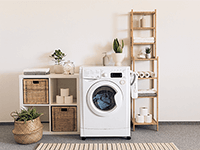
Energy efficiency has been on many people’s minds over the past year.
In September 2023, the Office of National Statistics said that, ‘almost half (47%) of adults in Great Britain are using less fuel such as gas or electricity in their homes because of the rising cost of living.’
As we head back into colder months, and with the cost of living in the UK increasing, energy efficiency is more important than ever.
By making some smart switches, you could improve the energy efficiency in your home, and hopefully save some money.
Lightbulbs
Replacing traditional filament/halogen light bulbs with energy efficient lightbulbs is a relatively cheap and accessible way to save energy in your home.
There are two main types of energy efficient bulbs: compact fluorescent lamps (CFLs) and light emitting diodes (LEDs).
LEDs are the most recent and energy efficient bulb to come onto the market. You can usually find LEDs to fit most lamps and fittings. They can be used as dimmable lights, spotlights and you can even find some that change colour to suit your room!
You can also improve the efficiency of your lights by remembering to turn them off when you leave the room and fitting motion sensors.
Slow cookers
Compared to running your oven, slow cookers are a great way to prepare food while using less energy.
Slow cookers typically operate at a low wattage, usually between 100 and 300 watts. This is significantly lower than other appliances like ovens, stoves or microwaves. They work by taking a longer time to cook your food, usually 6-8 hours, so they require a lower heat output.
Switching to a slow cooker for some of your meals can not only help you save money on energy, but if you eat meat, you can save money from buying cheaper cuts. This is because the long cooking time helps tenderise meat that could otherwise be very tough.
Air fryers
Air fryers are another type of kitchen appliance that can help you improve your energy efficiency.
They work by a heating element at the top of the fryer, and a fan to circulate the heat. They are much smaller than the typical oven, so they require much less energy to heat fully.
Air fryers are a smart investment for those looking to improve their energy efficiency as they typically cook food much more quickly than an oven and don’t take as long to pre-heat.
They can be especially useful for people who live alone, couples or small families, as they reduce the need to turn the oven on for a small amount of food.
Heated blankets/throws
Heated blankets and throws are a popular home comfort device that provide warmth, especially during colder seasons. You can use them all around your house, on your beds and sofas.
Heated blankets and throws provide localised heating, which means you can stay warm without having to heat an entire room. This is particularly useful if you want to conserve energy by avoiding the need to turn up the thermostat for the entire house.
They heat up quickly, so you don’t have to wait for a whole room to heat up in order to be warm. Often these devices also come with timers, so you can have them turn off after a set amount of time, helping reduce the amount of electricity you use.
Kettles
Your kettle may not seem like it would use a lot of energy, but if you use it often, it can really add up.
If you are looking for a new kettle, there’s a few things you should watch out for.
Firstly, make sure you get one that clearly shows how many cups of water are in the kettle. This helps you avoid boiling excess water which you may not use, meaning that electricity doesn’t go to waste.
Older kettles may not have a hidden element, meaning that the heating element is exposed to the water, which can make it tricky to clean. This can mean that limescale can easily build up inside, which can reduce the efficiency of the kettle. Look for kettles with hidden elements, most modern kettles will have this feature. This is especially important in areas with hard water, where limescale builds up easily.
Programmable thermostats
Programmable thermostats allow you to adjust the temperature of your home to suit you.
By switching to a programmable thermostat, you can choose the times you’d like to heat your home. This means you can save energy by ensuring you don’t have the heating running when you’re not home.
These thermostats can be especially useful if you are prone to forgetting to turn your heating off.
They also mean that you can set the heating to come on at convenient times, e.g. before you wake up, or before you come home from work. This means that you don’t have to wait for your home to heat up, making it more comfortable.
Summary
By making some smart switches, such as using slow cookers or air fryers for your meals instead of your oven, or using heated blankets to keep warm rather than putting your central heating on, you can use less energy.
Remember, even if you swap to more energy efficient appliances, you still need to maintain good energy-saving habits. Make sure you switch lights off when nobody is in the room, close doors between rooms to trap heat in one place, and switch-off electronics when not using them rather than leaving them on standby.
With this information you can make smarter choices about your energy consumption, ultimately leading to helping reduce your energy bills.




